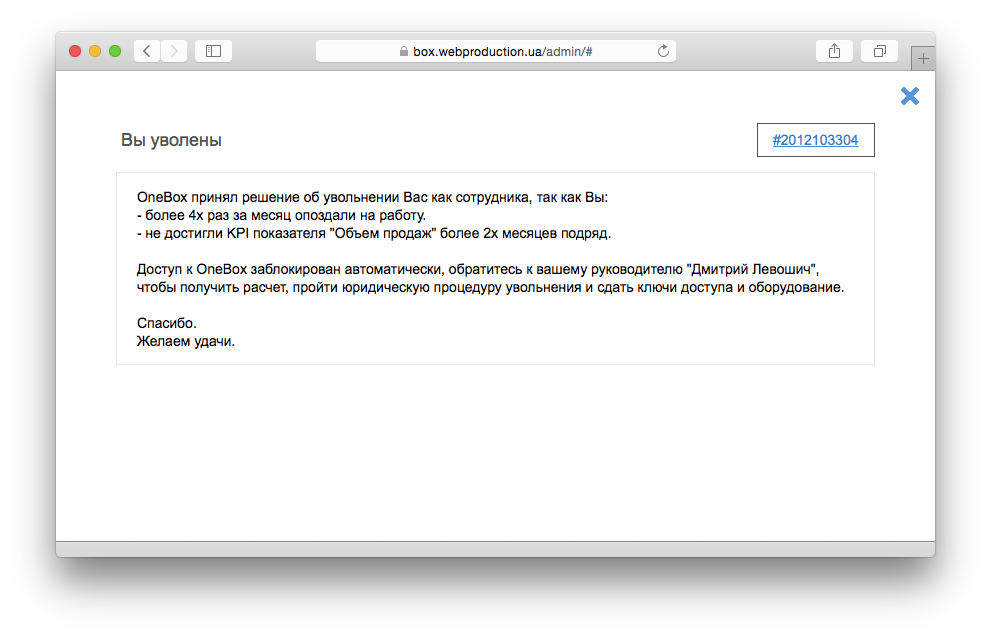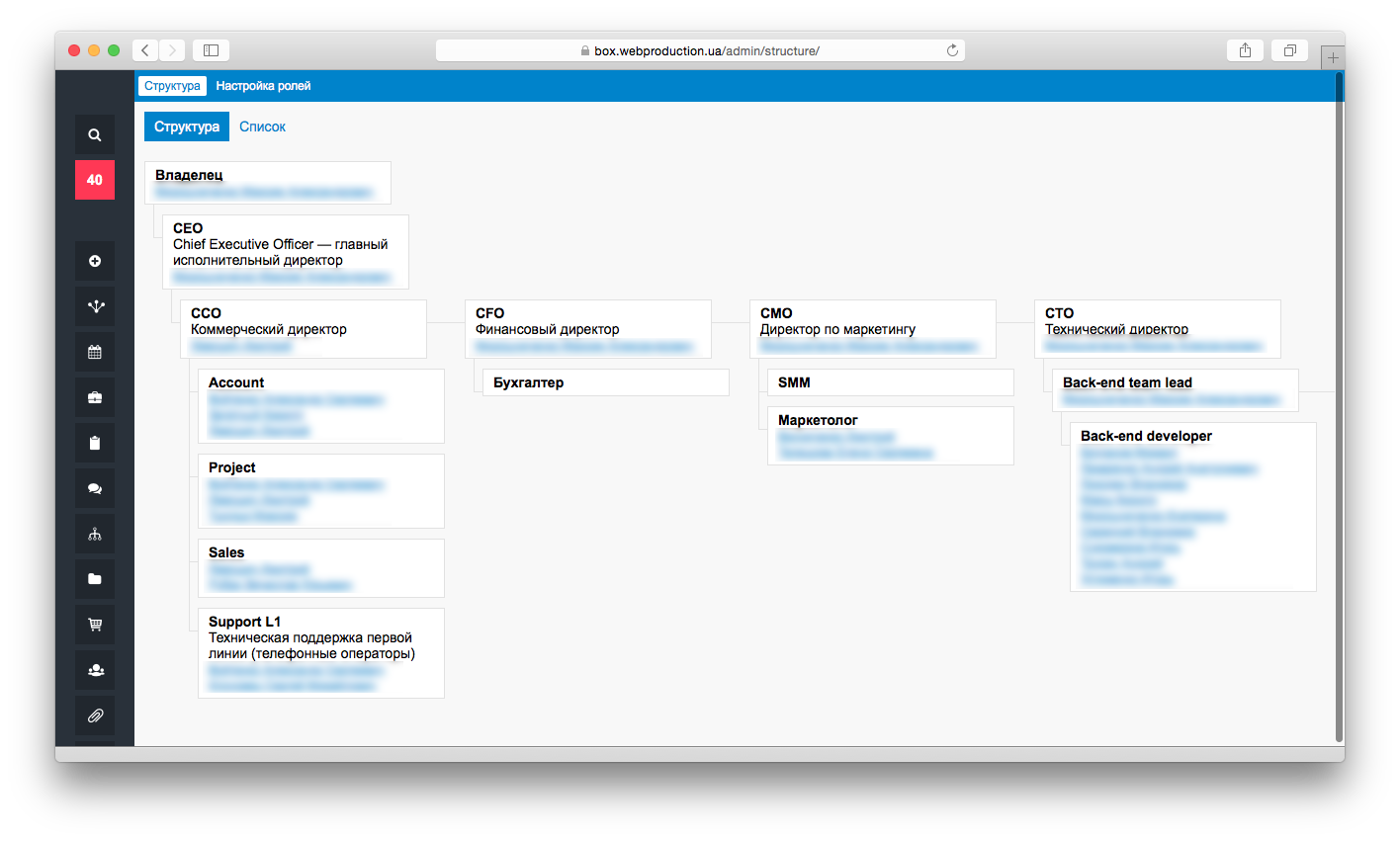Madness Automation: You're Fired
By the way, we taught OneBox to fire people based on custom rules and KPI (key performance indicators).
It's not a joke.

This is what the BOX system of full-fledged business management means, and not under-CRM.
But first things first.

Think about how much time you spend on selecting and hiring the person you need? Post a vacancy, select candidates, invite and check everyone ... Of course, this mechanism is not suitable for all roles, but we hire hiring back-end and front-end developers automatically.
How does OneBox understand that we lack staff? As we wrote earlier, CRM considers who performs how many tasks per day, and when the growth in the number of tasks in the last 2 months is more than the employees can complete, an automated decision is made “we lack XXX back-end developers”.
This decision can be confirmed or canceled by the manager, with one click. If it confirms, then OneBox:
When a person sends a response to the mail, the system automatically creates a task, a contact, links them together, and sends an automated response:
In the test task, we ask you to write a simple script that you need to commit to our repository. Correctness is checked by PHP CodeSniffer.
Once a day, OneBox checks the repository, if the necessary code is used, the system automatically:
The leader conducts an interview - and he has only two options in this task: suitable or not suitable. If suitable - OneBox:
If a person answers that he agrees, the system:
The system stops when the number of developers you need is balanced.
Of course, schedules, text of tasks and invitations are already predefined by a person. And the text is written personalized. Reaction conditions are also predefined.
If the employee does not answer in a standard way - this is seen by the person responsible for the hiring - and manual individual answers are turned on. And at any stage a person can intervene.
And now the most interesting: there are certain KPIs (key performance indicators) that cannot be violated. For example, for more than 2 consecutive months, the employee does not fulfill the minimum plan (although the minimum plan is completed in 2 weeks) - the system decides to dismiss him.
Of course, the rules of the game are known to both parties in advance and the chance of an unexpected dismissal is 0.
All rules are customizable.
OneBox signals in advance that "you are not coping, correct there." There are many such notifications, and you need to completely hammer in a job or an internship so that the system decides to "fire". All these metrics are publicly available, everyone sees them. Everything is transparent. And with a huge margin of time.
The purpose of the function is not to fire.The purpose of the function is to consolidate the goals and performance indicators and allow them to be achieved.
A lot of people say that dismissing is bad. And what about the performance indicators? Doing your tasks is a deception of the employer : theft of time and money in the company.
Of course, if our client does not want to use these functions, he will not use them.
First, the company’s orchscheme (role tree) is configured, then the rules for calculating KPI for each role, and only then after a while (when there are statistics) you can configure automated reactions to KPI.

In real business, a manager looks at KPI and decides "what to do next." If decisions are repetitive - why not automate?
It's not a joke.

This is what the BOX system of full-fledged business management means, and not under-CRM.
But first things first.
Automated hiring

Think about how much time you spend on selecting and hiring the person you need? Post a vacancy, select candidates, invite and check everyone ... Of course, this mechanism is not suitable for all roles, but we hire hiring back-end and front-end developers automatically.
How does OneBox understand that we lack staff? As we wrote earlier, CRM considers who performs how many tasks per day, and when the growth in the number of tasks in the last 2 months is more than the employees can complete, an automated decision is made “we lack XXX back-end developers”.
This decision can be confirmed or canceled by the manager, with one click. If it confirms, then OneBox:
- creates xxx@domain.com mail to which it will collect responses.
- publishes a vacancy on sites (since there is no API, then through a parser or WebDriver).
- begins to collect responses to mail.
When a person sends a response to the mail, the system automatically creates a task, a contact, links them together, and sends an automated response:
In the test task, we ask you to write a simple script that you need to commit to our repository. Correctness is checked by PHP CodeSniffer.
Once a day, OneBox checks the repository, if the necessary code is used, the system automatically:
- sends the candidate an invitation to an oral interview.
- to the head (technical director) sets the task for the right time to be in place and to interview the candidate.
The leader conducts an interview - and he has only two options in this task: suitable or not suitable. If suitable - OneBox:
- sends a standard job offer, which immediately describes all the working conditions, requirements for an internship and after.
- waiting for a human reaction for one week.
If a person answers that he agrees, the system:
- Forms and offers the candidate a date for joining the internship;
- the system administrator is tasked with “preparing a workplace”
- if there is no free equipment in the warehouse, it sends a notification to our partners with a request to ship the necessary components, and accountancy - to pay.
- on the right date, the employee is given access to OneBox (himself) and 150 internship tasks are scheduled for each day.
- on the desired date, the task is set for the manager to recruit a new employee.
The system stops when the number of developers you need is balanced.
Of course, schedules, text of tasks and invitations are already predefined by a person. And the text is written personalized. Reaction conditions are also predefined.
If the employee does not answer in a standard way - this is seen by the person responsible for the hiring - and manual individual answers are turned on. And at any stage a person can intervene.
Automated Dismissal
And now the most interesting: there are certain KPIs (key performance indicators) that cannot be violated. For example, for more than 2 consecutive months, the employee does not fulfill the minimum plan (although the minimum plan is completed in 2 weeks) - the system decides to dismiss him.
Of course, the rules of the game are known to both parties in advance and the chance of an unexpected dismissal is 0.
All rules are customizable.
OneBox signals in advance that "you are not coping, correct there." There are many such notifications, and you need to completely hammer in a job or an internship so that the system decides to "fire". All these metrics are publicly available, everyone sees them. Everything is transparent. And with a huge margin of time.
The purpose of the function is not to fire.The purpose of the function is to consolidate the goals and performance indicators and allow them to be achieved.
A lot of people say that dismissing is bad. And what about the performance indicators? Doing your tasks is a deception of the employer : theft of time and money in the company.
KPI Settings
Of course, if our client does not want to use these functions, he will not use them.
First, the company’s orchscheme (role tree) is configured, then the rules for calculating KPI for each role, and only then after a while (when there are statistics) you can configure automated reactions to KPI.

In real business, a manager looks at KPI and decides "what to do next." If decisions are repetitive - why not automate?
